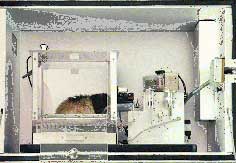
Skinner designed an apparatus, called a Skinner box, that allowed him to formulate important principles of animal learning. An animal placed inside the box is rewarded with a small bit of food each time it makes the desired response, such as pressing a lever or pecking a key. A device outside the box records the animal's responses.
B. F. Skinner (1904 - 1990)
B. F. Skinner's (Burrhus Frederick Skinner) elaboration of the theory of reinforcement and his advocacy of its application to learning helped to establish the Behaviorism and Programmed Instruction movement. Programmed instruction is characterized by clearly stated behavioral objectives, small frames of instruction, self-pacing, active learner response to inserted questions, and immediate feedback regarding the correctness of a response. Individualized instruction in essence replaces the teacher with systematic or programmed materials. Individualized instruction can be print-based, computer-based, or can use other media as long as the instruction is based on the concepts listed above. It is linear, in that the author of the materials decided what step to present next, and that step is presented, no matter what the learner wants. Although logical subject matter is easier to individualize into programmed materials, researchers have not found any subject matter that could not be programmed.During his 60-year career, Skinner discovered important principles of operant conditioning, a type of learning that involves rewards and punishments. A strict behaviorist, Skinner believed that operant conditioning could explain even the most complex of human behaviors.
In 1958, Skinner built a rote-and-drill teaching machine. Individualized instruction was originally presented in book form, and sometimes still is. In order to prevent students from looking at the answers in the book ahead of time, Program Instruction became automated by inserting it into a teaching machine. Teaching machines are devices that house, display, and present printed programmed instruction. Feedback is given when the program is advanced through actuation of a lever and the correct answer comes to view.
Programmed instruction is linear, in that the author of the materials decided what step to present next, and that step is presented, no matter what the learner wants. Later, in 1958, Norman Crowder developed what is called "intrinsic" or branching programming, in which the learner's possible responses are multiple choice, and the program branches according to the response chosen. In this way students could skip steps they already knew, or study remedial material on information already presented.